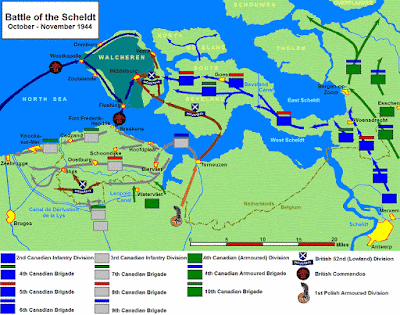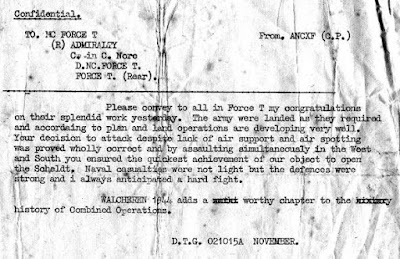 |
| Royal Marine Derrick Parsons |
As the Allied forces advanced deeper and deeper into Europe, the need for port facilities north of Normandy grew acute. Allied supply lines were moving farther and farther away from Normandy, where most of their supplies were landing in Europe, resulting in very long supply runs by truck to the Allied armies. Antwerp had fallen with intact port facilities in September 1944, however, the waterway leading to Antwerp, the Scheldt Estuary, was lined with German forces, and in particular heavy coastal batteries on Walcheren Island prevented any Allied supply ships from approaching the Scheldt in order to land supplies in Antwerp.
 |
| A schematic of the Battle of the Scheldt, of which Operation Infatuate, to capture and secure Walcheren, was a key part. |
Luckily, I've been able to locate a copy of the report of LCF's exploits written by its commander, Lieutenant Alfred George Whittington Wilks. It makes for harrowing reading, particularly if you are related to one of the men on board! The original record is quite difficult to read, in parts, so I've included the transcription below.
REPORT ON OPERATION
INFATUATE 1ST NOVEMBER 1944
LCF 38
At Ostend Roads weighed
and proceeded to form up at 0245 on LCGs with LCH 98 as guide.
Proceeded along swept
channel to position AA off Westkapelle, Walcheren Island.
From AA proceeded to
position BB with LCH 98 as guide in Order 1. The tide had a definite southerly
set and big alterations of course were necessary to maintain correct bearing.
At BB with LCH 98 as
guide quarter line to port was assumed. At approx. 0915 shelling of the Red
Flank by shore batteries began. At approx. 0920 signal from 98 to carry out
previous instructions. F38 became guide of Ps and proceeded at half speed as
Landing Craft were behind time and the circumstances it was felt that it was
best that they should be coming through while while the Ps were still able to
engage the enemy batteries.
At approx. 0935 while
about 2000yds from the beach salvos of rockets from our own rocketships began
to fall about 1 ½ cables from our port quarter. With wheel hard astarboard and
emergency full ahead we drew away from the line of fall. Bringing F38 back onto
her course emergency full ahead was maintained for some minutes. Reducing to
full we closed the beach. With F36 and F42 acting independently a slightly
zig-zag course was maintained to enable port and starboard batteries to fire in
turn. At about 1500 yds from the beach the port batteries opened up on the enemy
positions. At approx. 1000 yds from the beach we straightened up and headed for
the mound on the lefthand side of the gap. At approx. 0945 the shore batteries
began registering hits on both sides of the ship. Between 800 and 1000 yds from
the beach a 90 degree turn to port was made to engage enemy machine gun nests
and batteries south of the G(M) now beached. Fire was maintained until
dangerous to the G (M) but re-opened when she was out of line.
By this time we had
been hit by about ten heavy shells. The magazine flood was smashed, the
magazine on fire, the forward mess deck a foot under water, the wheelhouse a
shambles, the steering jammed, one engine gone, about five gun positions
smashed and the ward room on fire. Still all available armament maintained
constant fire on the enemy. Asking the Flotilla Officer to take over on the
bridge I went below to try to rig up some sort of steering. By disconnecting
the port rudder (damaged by hit) steering was obtained on the starboard rudder.
Being now a danger to incoming craft F36 was requested to take us in tow. Cease
fire was ordered and at approx. 1015 F36 came alongside and took us in tow,
still under heavy and accurate shell fire. Hoses were at once rigged to the
magazine from F36 but it was well ablaze and ammunition began to explode,
despite the use of hoses and foam. F36 was hit below the water-line on the
starboard side by a heavy shell. F38 received two more direct hits on the port
side. With the presence of F38 endangering the F36 and being no longer a useful
fighting unit it was decided to anchor her and then abandoned F38. Removing
wounded and one dead, leaving one dead aboard, dumping the CB chest overboard
and removing the vital parts of the QH to F36, F38 was abandoned at anchor at approx.
1035.
Wounded were
transferred to LCT 428 and the survivors sailed back to Ostend on F36.
The last report on F38
was she had blown up, her tanks had caught fire and she was well ablaze.
Through the whole of
the action, the ship’s company bore itself in a manner fully in keeping with
the highest traditions of both services. The guns were firing until the last
possible moment, the gunnery especially under the circumstances was excellent
and I believe effective. It is indeed very difficult to single out any man were
worthy of praise than another. Excellent discipline was maintained at all
times. Fire control was beyond criticism. The whole ship’s company fought with
characteristic determination. Some died at their posts.
The SBA’s Drummond and
Watkins did sterling work throughout.
AB Crothers with the
wheelhouse a shambles freed the wheel from the dead and took over.
Corporal Miller
performed excellent work throughout and after the action.
OCRM Lieut Clifford was
very calm and decisive during the entire action. The amazing steadiness and
brilliant efficiency of the Royal Marines was undoubtedly due to their training
and his presence.
Lieut Hewitt RM directed
fire by manning the after oerlikons and did fine and accurate work, until his
gun was blown up, his crew killed and he was severely wounded.
Sub/lt Maclean after
but one week as First Leutenant showed a veteran’s poise and performed his multitudinous
duties with great skill and perseverance.
I am indebted greatly
to Lieut-Commander Lammert RNVR and Lieut D. Thomas RNVR for their services
rendered to F38.
Orders had been carried
out. Support had been given.
Casualties:
Killed – 4.Died of wounds – 1.
Wounded (including slightly wounded) – 20 approx.
The survivors were taken
back on F36 where they were divided between F36
and F35 and routed back to the UK.
Lt. Alfred George Whittington Wilks
Lieutenant RNVR
Commanding Officer.
 |
| The message from the operations commander on board HMS Kingsmill, the lead battleship and effective HQ for the operation, to all stations after the Westkapelle attack |
 |
| Signal from Admiralty to operations commander after beachhead assault at Westkapelle November 1 |
 |
| A personal note sent to all on LCF 38 and who survived the action. It wasn't the style of the officer classes to use Christian names! |
I'll leave the last words of this post to the son of Lieutenant Wilks: "I can only speak about my father’s vessel and her crew, but I am sure that others were the same. LCF 38 as lead attack vessel in that sector, charged in with a thousand horse power thundering in her engine room and all guns blazing, keeping accurate fire with some shells penetrating gun slits. These men were not just doing their job, they were warriors of the highest order in the full knowledge that, for the objective to succeed, it could result in the total loss of the ship and all hands. The document I find particularly moving is the high praise of the actions of the close support flotilla especially the LCF, LCG, and LCS. Knowing my father and his crew were real warriors in the thick of it, and the recognition they got, makes me intensely proud".
 |
| Derrick Parsons x2, taken in about 1948, some 4 years after Walcheren. It could have turned out so differently. |




No comments:
Post a Comment